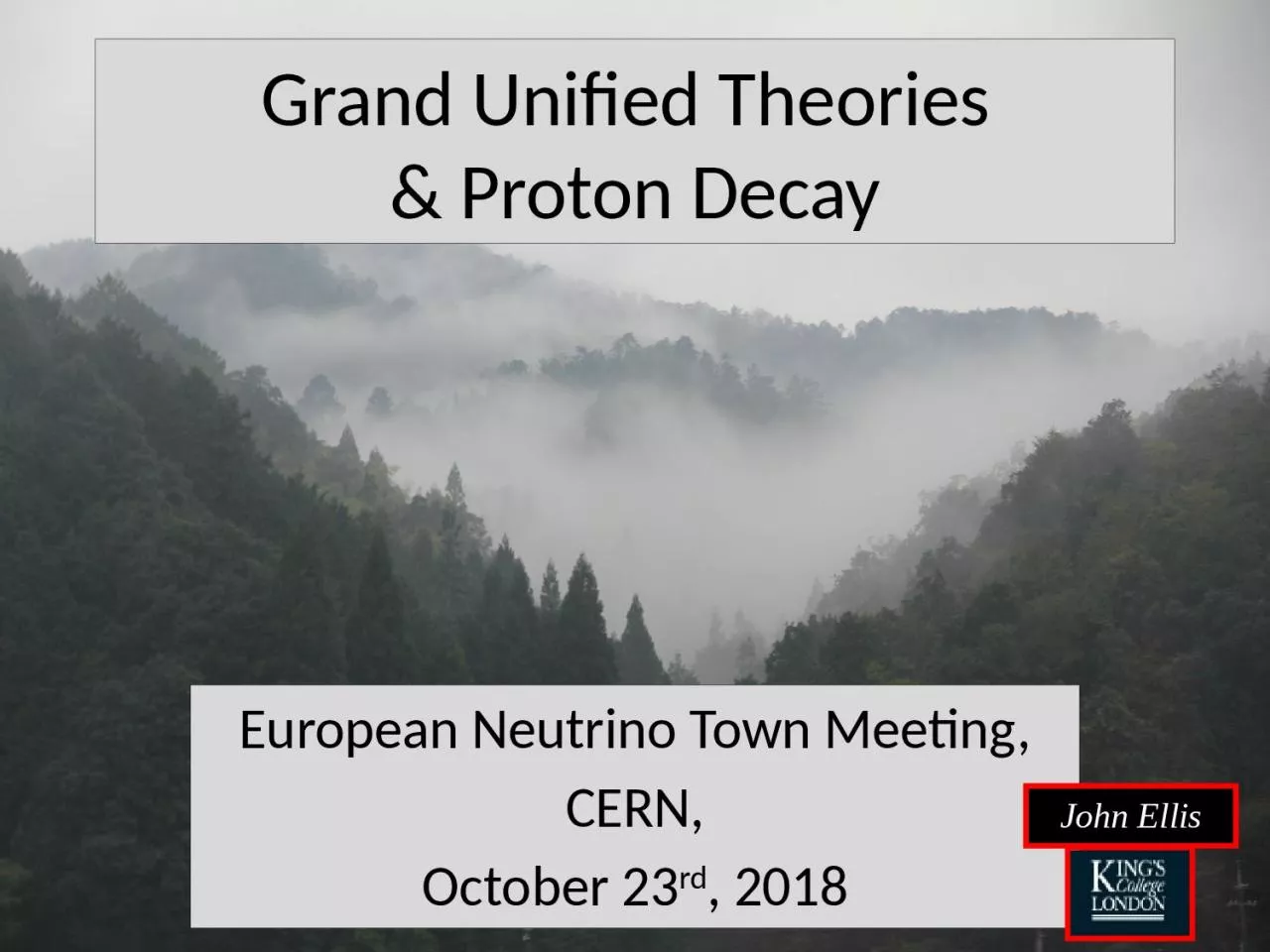

European Neutrino Town Meeting CERN October 23 rd 2018 John Ellis Questions from Alain Is there a clear reason why protons should decay Why is it said that p Kv is a ID: 1001689
Download Presentation The PPT/PDF document "Grand Unified Theories & Proton Dec..." is the property of its rightful owner. Permission is granted to download and print the materials on this web site for personal, non-commercial use only, and to display it on your personal computer provided you do not modify the materials and that you retain all copyright notices contained in the materials. By downloading content from our website, you accept the terms of this agreement.
1. Grand Unified Theories & Proton DecayEuropean Neutrino Town Meeting,CERN,October 23rd, 2018John Ellis
2. Questions from AlainIs there a clear reason why protons should decay?Why is it said that p Kv is a supersymmetric mode? Is p e+π0 suppressed in that case?What is the relative p e+π0 vs p Kv rate in different models?Are there models where the kaons dominate?Why should the GUT multiplets be made of quarks and leptons of the same family number?Is there any consequence of this assumption in terms of proton decay rate?
3. Grand unified theories proposed in 1973/4, predicted baryon decayBlack holes have no memory of baryon # (B)Quantum # conserved only if gauge symmetrye.g., U(1) gauge symmetry & electric chargeB violated by non-perturbative effects in SMB would be violated by magnetic monopolesNo global symmetries in string theoryWhy Protons are not Forever Pati & SalamGeorgi & Glashow1973, 1974
4. Baryons violate Baryon NumberProperties of black holes determined by mass, spin, electric charge (colour), thermodynamicsBlack holes ‘forget’ global symmetries like BBlack holes decay, must produce baryonsBaryons Black holes can decay baryonscan fall in, be ‘forgotten’Hawking, Bekenstein1973, 1974
5. Proton Decay via Gravitational Interactions?Four-fermion interaction ~ Newton constant GN = 1/mP2, mP ~ 1019 GeVRate ~ GN2 × (GeV)5Lifetime ~ 1045 yrsZeldovich1976
6. Electroweak instantons violate B, LChange each of electron, muon, tau numberChange numbers of 1st, 2nd & 3rd generation q ΔB = ΔL = 3Do not give rise directly to baryon decayCould have played role in baryogenesisNon-PerturbativeB Violation in SM‘t Hooft1976
7. Cosmological BaryogenesisOrigin of baryon asymmetry of Universe?Non-perturbative electroweak processes unsuppressed in early UniverseCould convert primordial L asymmetry (partially) into B asymmetryL asymmetry could come from CP violation in decays of heavy (singlet) neutrinosRequires Majorana ν (0ν2β decay?)CP-violating phase ≠ oscillation phaseSakharovFukugita & Yanagida19671987
8. B is Accidental Symmetry of the SMThe Standard Model does not allow any B-violating interactions of dimension ≤ 4But there are B-violating interactions of dimension ≥ 6Would be suppressed by some high mass scale as in GUTs ~ 1/M2Weinberg1979
9. GUTs have magnetic monopolesSymmetry restored in monopole core, quarks sucked inLarge rate for ΔB in monopole scatteringAre there any monopoles in our Universe?Monopole Catalysis of B DecayRubakovCallan1981, 1982
10. No Global Symmetries in Stringy GravityHas long been ‘folk wisdom’Strings move along worldsheetsGlobal symmetries on the string world-sheet lead to gauge symmetries in space-time, not globalAdS/CFT correspondence: gravity in ‘bulk’ space, particles on boundaryGlobal symmetries on boundaryassociated with gauge symmetries in bulk, not globalBanks & Seiberg
11. Weak Gravity Conjecture‘No force can be weaker than gravity’Consider compactified string model with gauge symmetryWhat happens when gauge coupling g small?Compactification ‘unravels’: infinite tower of massive states become masslessGlobal symmetry would be limit g = 0Inconsistent with weak gravity conjectureLee, Lerche & Weigand20182006Arkani-Hamed, Motl, Nicolis & Vafa
12. Conflict with AdS/CFT CorrespondenceSuppose there is a global symmetry in the bulkWould global symmetry on the boundaryCould be split into symmetry in different parts of boundaryBut these would commute with operator in the middle of the bulkNo non-trivial global symmetryHarlow & Ooguri2018
13. Simplest Grand Unified TheoriesElectromagnetic charge embedded in simple group: charge quantizedMinimal model: SU(5)Fermions of a single generation accommodated“Explain” “random” quantum numbersRenormalization prediction for sin2θWGeorgi & Glashow1974
14. Grand Unification of CouplingsAlmost works with just Standard Model particlesBetter with supersymmetric particlesGeorgi, Quinn & Weinberg1974
15. Quark and Lepton MassesAlso vary with moment/energy scale where you measure themCould they be equal at some fundamental level?e.g., in grand unified theory such as SU(5)One-loop renormalization:Successful PREdiction of bottom massNot so successful for lighter quarks/leptonsChanowitz, JE & Gaillard1977
16. Prediction for mb in terms of mτ suggests identification of 3rd-generation q and l: {b, t, τ}Analogous predictions for 1st and 2nd generations qualitative, not quantitativeSuggests (small) mixing corrections to naive generation structure: p e+π0, νπ+, μ+K0, νK+ so that whereLifetime too short?B Decay in Original SU(5)Georgi & Glashow1974
17. B-violating operators of dimension 5 without with squarks, sleptons: qqqlDressed with Higgsino, Wino exchange operators of dimension 6 with quarks, sleptonsCoefficientAntisymmetry in colour indices u,d,s quarksPreferred decay modes:B Decay in Supersymmetric SU(5)~~Dimopoulos, Raby & Wilczek1982
18. Lifetime depends on sparticle spectrumExample in specific SUSY Model (constrained MSSM)Lifetime in 1035 yrsLimit 6.6 ✕ 1033 yrs------ Higgs mass__ LHC, FCC reaches for sparticlesB Decay in Supersymmetric SU(5)JE, Evans, Mustafayev, Nagata & Olive2016
19. Decay rate, branching ratios also depend on unknown phasesFactor ~5 uncertainty, p π+ν may even dominateB Decay in Supersymmetric SU(5)JE, Evans, Mustafayev, Nagata & Olive2016
20. B Decay in Flipped SU(5)Flip quark and lepton assignments in 5, 10 u d, e,μ νDimension-5 operators suppressedBack to dimension-6, largerNo prediction for mb, could change multiplet assignmentsDominant decay could be or or _Antoniadis, JE, Hagelin & Nanopoulos1987
21. Great Irony of Physics History?Kamiokande experiment constructed to look for proton decay“nde” = nucleon decay experimentSuper-Kamiokande discovered ν oscillationsDUNE, Hyper-Kamiokande proposed to measure ν oscillationsWill they discover proton decay?Or a passing magnetic monopole?What next if proton decay discovered?Explore decay modes larger detectors?